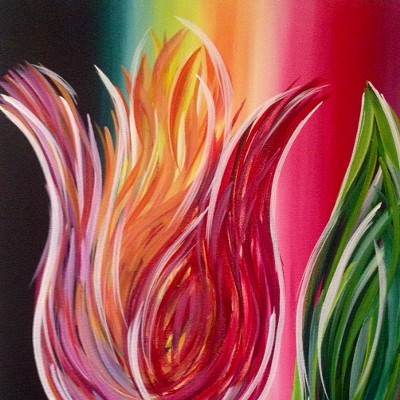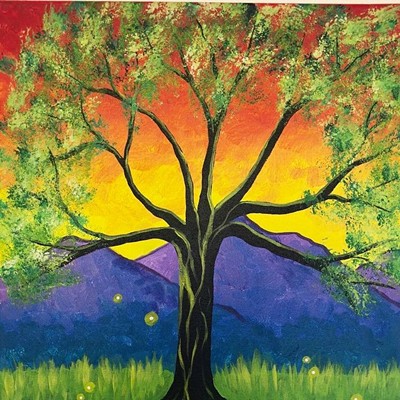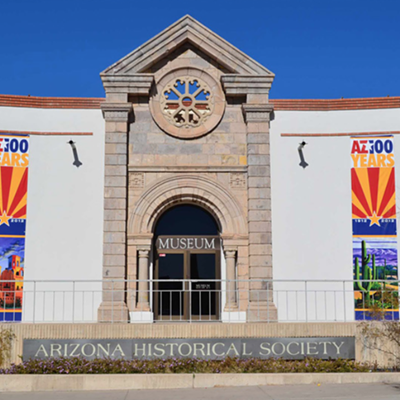Her "Landing in the Desert Near You" is a mixed-media wall piece of considerable charm. Its painted wooden box is shaped into a classic kids'-style house-with-pointy-roof, and the house's landscaping is lovely, in the form of big green prickly pear pads in pâpier-maché and pointy copper wires. Inside the house box Bartimole has painted a deep-blue Tucson summer night sky, but it presides over a painted hillside crowded with the kind of ticky-tacky houses once torpedoed in the folk song "Little Boxes." A couple of the painted houses have evolved into the third dimension, solid forms that sit on a shelf. They're made of pâpier-maché too, and leaking through the thin paint are the words printed on the newspaper ads Bartimole uses as her raw material: New Homes.
Bartimole's been clever here, getting in under the Space rules on a technicality. She's made the prickly pear pads double as wings, and her whole little suburban subdivision has alighted fully formed on the desert's doomed ironwoods. It's an evil visitation, as it were, from an outer space empire of rapacious developers.
Obsidian proprietor Elouise Rusk doesn't mind that Bartimole flexed the rules. In fact, she enjoys seeing how artists improvise upon the theme for each year's summer invitational.
"Some of them did Tucson, some of them did space, some of them did both. Some people interpreted it as elbow space," she explains cheerfully. "That's what happens when you work with artists."
And, anyway, Bartimole was a bit more compliant in her "What Goes Up Must Come Down." This towering green pâpier-maché saguaro, stretching up five feet from its launching pad on the floor, has silver rocket wings about to propel it into space. Still, the artist hasn't abandoned her subversive message. Real estate ads peeking through the saguaro's green paint--"All New Community!" "3.3 Acre Custom Homesites!"--betray Tucson's tiresome propensity to destroy itself.
For this year's otherwise lighthearted show on space, Rusk invited some 50 local and out-of-town artists proficient in just about any medium you could imagine. Cloth, metal, leather, cut-out wood, glass, ceramic tile and found plastic toys jostle for space with traditional paint on canvas, colored pencil on paper and ink prints. Most of the artists took flight on the space idea, and there's a preponderance of stormy Tucson skies, of silver rocket wings, of saguaros glimpsed from outer space.
Jewelry maker Kit Carson even worked the theme into a bolo tie: it's decorated by a space cowboy riding a bucking rocket into the stratosphere. Fiber artist Kathyanne White made a lovely quilted rendition of the inky night sky, laced with striped fabric lightning bolts. "Night Skies Starpath" has a background fabric batiked in shades of navy, and all across its surface White has trailed tiny quilting stitches in undulating lines of faint orange, blue and green. In White's deft hands, the cloth has become a thing alive: a pulsing sky about to crack open.
Aimee Baker is the plastic animal wrangler. Her "Noah's Ark" has nothing much to do with Tucson, but it's a fine rocket composed entirely of plastic turquoise sharks, giraffes, camels and the like, a 21st-century escape hatch for the earth's endangered animals. Karl Vidstrand has likewise glued hundreds of fragments of mirror and colored tile to two wooden figures. Stacked one atop the other, they're benevolent space aliens. Their title is their greeting: "Higher Higher or We Come in Peace."
In the conventional materials division, Tom Bergin made a monoprint of a saguaro beneath a lively sky; his "Crested Saguaro at Sunset" is the most representational piece in the show. Other painters stayed more fanciful. Charlotte Bender turned to familiar colored pencils for her spacey "Chariot," but with them she's concocted a gleaming flying saucer hovering over the desert's deep canyons and bristling saguaros. Lynn O'Brien, another painter, uses standard acrylic paint and canvas for "Maverick," but she's shaped the canvas into a rocket-robot, and the disciplined painting she's put on it is a cartoonish rendering of fat rocket ships cavorting through the atmosphere.
One of the loveliest--and most intellectual--pieces is Melissa Haid's "Here to There and Back," a glass and metal hanging sculpture. Tethered by wires to the ceiling, its six greenish glass panels cast flickering lighted reflections on a nearby wall. A New Mexico artist, Haid has embedded silvery squares of mica and colored beads into her recycled window glass, stringing the squares out into patterns that echo those evanescent rectangles over on the wall. "Here to There" is a fine meditation on light and motion and space, a sophisticated visual abstraction of the universe's physical poetics.
Tucson in Space continues through Saturday, Sept. 9, at Obsidian Gallery, St. Philip's Plaza, Suite 90, 4340 N. Campbell Ave. An opening reception will be held Saturday, July 8, from 6 to 9 p.m. Regular gallery hours are 10 a.m. to 5:30 p.m. Monday through Saturday. For more information call 577-3598.














